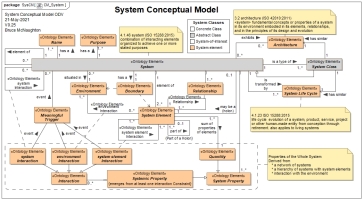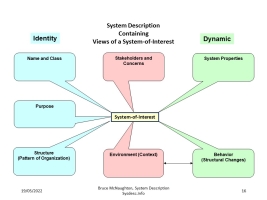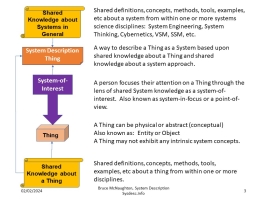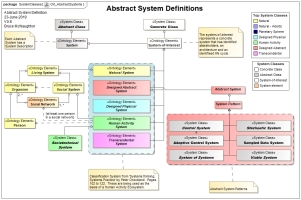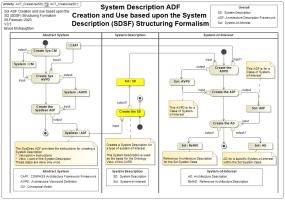System Science
Overview
System Science provides a way to identify and describe systems to understand their inherent change mechanisms.
The concepts used in this section have been synthesised from the following work:
- Russell Ackoff
- Ludwig von Bertalanffy
- Fritjof Capra
- Peter Checkland
- INCOSE (including Hillary Sillitto, Simon Perry, Jon Holt)
- ISO 42010:2011 (Rich Hilliard)
- ISO 15288:2015.
- John Mingers (Critical Realism)
- Peter Senge
This work has addressed the following questions:
- What is a system?
- What are its system elements and interactions?
- What are the contents / headers of a System Description for any identified?
- How can a thing be described as a system?
- What are the criteria to verify and validate the system description?
Core system pattern is shown below:
The second image maps the Ontology Elements to a viewpoint that is used in the system description.
System Description
The concept of a system description came from Peter Checkland's use of a Root Definition for a Human Activity System. The views of a system-of-interest are shown below:
The System Description includes the following sections representing views of the system-of-interest:
- System Name and Class
- System Purpose
- System Properties
- System Stakeholders and their concerns
- System Environment (Context)
- System Structure (Pattern of Organization)
- System Behavior (Structural Changes)
- Correspondences
- Decisions and Rationale
- References
The system description allows a thing to be seen as a system. The following shows the context for the System Description.
System Patterns
In addition, this lead to the investigation of abstract system patterns. These are patterns that are used as the base abstract classes for other systems. The following diagram identifies some of the types of systems that have been investigated. Each has a system description:
System Classification
Finally, this has led to the identification of a classification system for all systems. This search led to the System Classification System in Peter Checkland's book: Systems Thinking; Systems Practice.
System Classification Framework
A System Classification Framework provides a way to position a system-of-interest in a wider context of systems. This System Classification Framework is used to:
-
Identify types of systems.
-
Promote reuse across a set of systems and system types
-
Ensure alignment of similar types of systems and reduce duplicate definitions.
The System Classification Framework provides the following benefits:
-
A top level set of system types that can be used for any system-of-interest.
-
A way to reuse aspects of systems using generalizations that allow inheritance of the key elements of a system.
-
A way to integrate across systems based upon consistent references to defined systems using a single abstract system class..
-
A way to reuse AD Elements across the full set of defined systems (e.g. viewpoints, views, view components, other system descriptions, etc).
The top level System Classification Framework is based upon Peter Checkland's system classification model. Peter Checkland includes a system classification approach in his book Systems Thinking, System Practice. The following form the top level set of systems in this classification scheme:

The top level System Classification Framework is described in the book from page 102 to page 122. Figure 4, page 112 highlights the 5 system classes. These classes are used as a top level classification for system types.
Link to the Top System Classifications PDF
Russell Ackoff's System Classification
Russell Ackoff's System Classifications were also considered. The following types of systems comes from Re-Creating the Corporation
- Deterministic System
- Animated System
- Social System
- Ecological System.
These classifications were considered; however, they use are use "Purposeful System" as a differentiator between system types and was considered too narrow for this System Classification Framework.
Current Systems in the System Classification Framework
. The current systems that have been identified using the top level classification types are shown in the diagram below:

Note: that all of the types of systems are based upon a single definition and model of an abstract system. Each system inherits the single definition of system. This provides a consistent way to describe each type of system using a System Description based upon the SysDesc ADF.
Architecture Description Frameworks
This work has been formalized through the use of the COMPASS Architectural Framework Framework (CAFF) to create an Architecture Description Framework where the output of this Architecture Description Framework is a 'system description' in the same way that an Architecture Description is created to express an architecture of a system-of-interest. The process is shown in the left side of the diagram below.
Please see the System Architecture Description Framework
